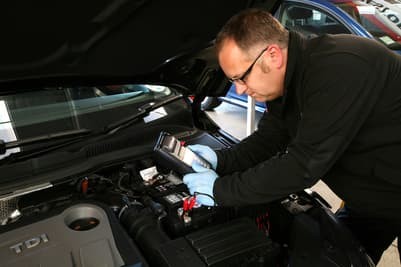Like many components in your vehicle, car batteries are not designed to last forever. Typically, a car battery’s lifespan ranges from 3 to 5 years. While many batteries come with a warranty, knowing the manufacturing date of your battery can be incredibly useful. Whether you’re trying to gauge remaining life, assess a used car’s battery condition, or simply for your vehicle maintenance records, determining your car battery’s age is a straightforward process. This guide from obd-de.com will walk you through exactly how to check the age of your car battery and what that age might indicate about its health and remaining service life.
 Close-up of a car battery terminal and date code
Close-up of a car battery terminal and date code
Why Knowing Your Car Battery Age Matters
Understanding the age of your car battery is more than just a matter of curiosity; it’s a proactive step in vehicle maintenance. Here’s why it’s important:
- Predictive Maintenance: Car batteries have a limited lifespan. Knowing the age allows you to anticipate when it might be nearing the end of its usable life, helping you avoid unexpected breakdowns and inconvenient no-start situations.
- Used Car Assessment: If you’re purchasing a used vehicle, checking the battery age can be a valuable part of your inspection. A very old battery in a used car might need replacement soon, which is an expense you should factor in.
- Warranty Verification: While the original article mentions warranties of 4 or 5 years, knowing the manufacture date helps you confirm if your battery is still within its warranty period, should any issues arise.
- Performance Monitoring: As batteries age, their performance can degrade, especially in extreme temperatures. Knowing the age allows you to be more attentive to signs of weakness, like slow engine cranking, particularly in winter or summer.
Decoding the Mystery: Finding the Age Code
The most direct way to determine your car battery’s age is by locating the manufacturing date code. This code is typically stamped or printed directly onto the battery casing or a sticker attached to it. Here’s what to look for and how to decipher it:
1. Look for a Date Sticker or Stamp
Many battery manufacturers will include a straightforward date sticker, often showing the month and year of manufacture. This might be in a format like “MM/YY” or “Month Year” (e.g., “03/23” or “March 2023”). This is the easiest to read and interpret. Inspect the top, sides, and front of the battery casing for such a label.
2. Identifying the Manufacturing Code
If there isn’t a clear date, you’ll need to find the manufacturing code. This is usually a combination of letters and numbers. The key information—the date of manufacture—is typically embedded within the first two characters of this code.
-
Year Code: The first character is often a number representing the last digit of the year of manufacture. For example, “3” could indicate 2023, “2” could be 2022, and so on. It’s important to consider the context; if your car is only a few years old, “3” most likely means 2023, not 2013.
-
Month Code: The second character is usually a letter representing the month of manufacture. A common system uses letters A through L to represent January through December respectively:
- A = January
- B = February
- C = March
- D = April
- E = May
- F = June
- G = July
- H = August
- I = September
- J = October
- K = November
- L = December
Therefore, a code like “3C” or “C3” would indicate a battery manufactured in March 2023. Note that the order of the year and month (number then letter, or letter then number) can vary between manufacturers, but the characters themselves and their meaning generally remain consistent.
Step-by-Step Guide: Checking Your Car Battery Age
Let’s break down the process into simple steps:
- Safety First: Ensure your vehicle is turned off and, ideally, has been off for a little while. Locate your car battery, usually under the hood, but sometimes in the trunk or under the back seat.
- Visual Inspection: Look for a date sticker first. This is the quickest way to find the age. Check all sides of the battery.
- Find the Code: If no date sticker is visible, search for a stamped or printed code on the battery casing. It might be near the terminals, on the side, or top of the battery.
- Decode the Code: Identify the first two characters of the code. Use the year/month decoding method described above to determine the manufacturing date.
- Estimate the Age: Calculate the age of the battery by subtracting the manufacturing date from the current date. This will give you an estimate of how old your car battery is.
What to Do with This Information
Once you’ve determined the age of your car battery, consider the following:
- If your battery is 3 years old or older: Start paying closer attention to any signs of battery weakness, such as slow engine cranking, especially in cold weather. Consider having a battery health check performed by a professional.
- If your battery is approaching or beyond 5 years old: It might be time to proactively replace it. While some batteries can last longer, exceeding the typical lifespan increases the risk of failure.
- Combine with Performance Checks: Age is just one factor. Regularly check for other indicators of battery trouble, such as warning lights on your dashboard or difficulty starting your car, as mentioned in the original article.
By understanding how to check your car battery’s age, you empower yourself with valuable knowledge for maintaining your vehicle and avoiding unexpected battery failures. Regular checks and proactive replacement when necessary can save you from inconvenient breakdowns and ensure your car is reliable for years to come.